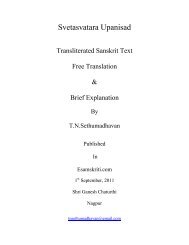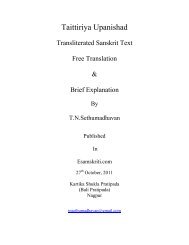Gujarat Governance for Growth and Development ... - Esamskriti.com
Gujarat Governance for Growth and Development ... - Esamskriti.com
Gujarat Governance for Growth and Development ... - Esamskriti.com
You also want an ePaper? Increase the reach of your titles
YUMPU automatically turns print PDFs into web optimized ePapers that Google loves.
<strong>Gujarat</strong>: <strong>Governance</strong> <strong>for</strong> <strong>Growth</strong> <strong>and</strong> <strong>Development</strong> < PREVIEW ><br />
consolidation. Historically, the problem has been with the revenue<br />
deficit, especially after 2008, both because revenue receipts have been<br />
lower <strong>and</strong> because revenue expenditure has been higher. However,<br />
since 2011-12, the revenue deficit numbers have also begun to look<br />
respectable <strong>and</strong> the deficit numbers are marginally better than what<br />
the 13th Finance Commission envisaged. One of the building blocks<br />
of the <strong>Gujarat</strong> model, so to speak, is to free up space <strong>for</strong> private sector<br />
expenditure in capital <strong>for</strong>mation. One cannot expect capital expenditure,<br />
as a share, to increase overnight. The bulk (76%) of capital expenditure<br />
is developmental, with social services accounting <strong>for</strong> 55.2%. Of the<br />
total expenditure, 66.41% is also developmental. 63.2% of revenue<br />
expenditure is developmental. To the extent this reveals a prioritization<br />
according to sectors, the major ones are education, sports, art <strong>and</strong><br />
culture <strong>and</strong> water supply, sanitation, housing <strong>and</strong> urban development, in<br />
that order. The fiscal consolidation <strong>and</strong> fiscal space created has enabled<br />
<strong>Gujarat</strong> to plug the gaps in Central sector <strong>and</strong> Centrally sponsored<br />
schemes with State-level schemes. The story isn’t that much about<br />
increasing public expenditure. It is more about creating an environment<br />
<strong>for</strong> private expenditure. Apart from private expenditure, the story is<br />
about increasing the efficiency of public expenditure, more bang <strong>for</strong> the<br />
buck, so to speak.<br />
Physical infrastructure<br />
In the power sector, the background is partly the <strong>Gujarat</strong> Electricity<br />
Industry (Reorganization <strong>and</strong> Regulation) Act of 2003. This allowed the<br />
transfer of assets <strong>and</strong> liabilities of the <strong>for</strong>mer <strong>Gujarat</strong> Electricity Board<br />
(GEB). Generation assets were transferred to <strong>Gujarat</strong> State Electricity<br />
Corporation Limited (GSECL). Transmission assets were transferred<br />
to <strong>Gujarat</strong> Transmission Corporation Limited (GETCO). Four different<br />
distribution entities were <strong>for</strong>med – Uttar <strong>Gujarat</strong> Vij Company<br />
Limited (UGVCL), Dakshin <strong>Gujarat</strong> Vij Company Limited (DGVCL),<br />
Pashchim <strong>Gujarat</strong> Vij Company Limited (PGVCL) <strong>and</strong> Madhya <strong>Gujarat</strong><br />
Vij Company Limited (MGVCL). <strong>Gujarat</strong> Urja Vikas Nigam Limited<br />
(GUVNL) had residuary functions, including that of power trading.<br />
GUVNL was the holding <strong>com</strong>pany. The <strong>Gujarat</strong> Electricity Regulatory<br />
Commission had been set up in 1998 <strong>and</strong> was brought under the<br />
purview of the Electricity Act of 2003. Generation became exempt<br />
3














